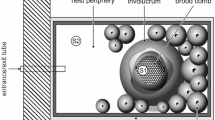Summary
Male pied flycatches Ficedula hypoleuca regularly feed their mates during incubation. By experimentally supplying some females with extra food we studied how the female's nutritional state affected her incubation schedule and the rate at which her mate fed her. Females that received extra food spent more time on the nest and shorter periods away from it, compared with control females. This suggests that nest attentiveness is governed by the amount of energy available to the female. When females reccived extra food, males decreased their rate of incubation feeding. They also did so in response to increasing ambient temperatures, whereas incubation schedules were unaffected. We, therefore, conclude that our results support the “female nutrition hypothesis”, i.e., that the food provided by the male constitutes a significant nutritional contribution to the incubating female.
Similar content being viewed by others
References
Askenmo C (1982) Clutch size flexibility in the pied flycatcher Ficedula hypoleuca. Ardea 70:189–196
Biebach H (1979) Energetik des Brütens beim Star (Sturnus vulgaris). J Orn 120:121–138
Biebach H (1986) Energetic of rewarming a clutch in Starlings (Sturnus vulgaris). Physiol Zool 59:69–75
Curio E (1959) Verhaltensstudien am Trauerschnäpper. Z Tierpsychol [Suppl 3]:1–118
East M (1981) Aspects of courtship and parental care in the European Robin Erithacus rubecula. Ornis Scand 12:230–239
Haartman L von (1958) The incubation rhythm of the female pied flycatcher (Ficedula hypoleuca) in the presence and absence of the male. Ornis Fenn 35:71–76
Haftorn S, Reinertsen RE (1985) The effect of temperature and clutch size on the energetic cost of incubation in a freeliving blue tit (Parus caeruleus). Auk 102:470–478
Kluijver HN (1950) Dally routines of the great tit, Parus m. major L. Ardea 38:99–135
Krebs JR (1970) The efficiency of courtship feeding in the blue tit Parus caeruleus. Ibis 112:108–110
Krebs JR, Dawkins R (1984) Animal signals: mind-reading and manipulation. In: Krebs JR, Davies NB (eds) Behavioural ecology: an evolutionary approach, 2nd edn. Blackwell, Oxford, pp 380–402
Lack D (1940) Courtship feeding in birds. Auk 57:169–178
Lifjeld JT, Slagsvold T (1986) The function of courtship feeding during the incubation in the pied flycatcher Ficedula hypoleuca. Anim Behav 34:1441–1453
Lifjeld JT, Slagsvold T, Stenmark G (1987) Allocation of incubation feeding in a polygynous mating system: a study on pied flycatchers Ficedula hypoleuca. Anim Behav 35:1663–1669
Lyon B, Montgomerie RD (1985) Incubation feeding in snow buntings: female manipulation or indirect male parental care? Behav Ecol Sociobiol 17:279–284
Lyon B, Montgomerie RD (1987) Ecological correlates of incubation feeding: a comparative study of high arctic finches. Ecology 68:713–722
Morley A (1949) Observations on courtship-feeding and coition of the marsh-tit. Br Birds 42:233–239
Nilsson J-Å, Smith HG (1988) Incubation feeding as a male tactic for early hatching. Anim Behav 36:641–647
Nisbet ICT (1973) Courtship-feeding, egg-size and breeding success in common terns Sterna hirundo. Nature 241:141–142
Ricklefs RE (1974) Energetics of reproduction in birds. In: Paynter RA Jr (ed) Avian energetics. Publ Nuttall Ornithol Club 15:152–292
Royama T (1966) A re-interpretation of courtship feeding. Bird Study 13:116–129
Webb DR (1987) Thermal tolerance of avian embryos: a review. Condor 89:874–898
White FN, Kinney JL (1974) Avian incubation. Science 186:107–115
Wilkinson L (1987) SYSTAT The system for statistics. SYSTAT, Evanston, Ill
Vleck CM (1981) Energetic cost of incubation in the zebra finch. Condor 83:229–237
Author information
Authors and Affiliations
Rights and permissions
About this article
Cite this article
Smith, H.G., Källander, H., Hultman, J. et al. Female nutritional state affects the rate of male incubation feeding in the pied flycatcher Ficedula hypoleuca . Behav Ecol Sociobiol 24, 417–420 (1989). https://doi.org/10.1007/BF00293270
Received:
Accepted:
Issue Date:
DOI: https://doi.org/10.1007/BF00293270




